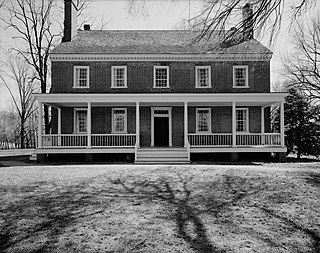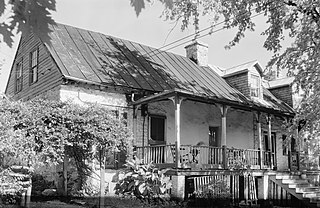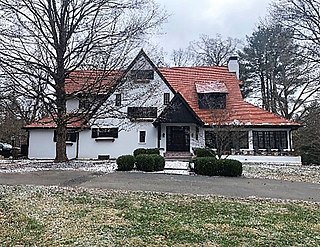
Jefferson County is a county located in the north central portion of the U.S. state of Kentucky. As of the 2020 census, the population was 782,969. It is the most populous county in the commonwealth.

Indian Hills is a home rule-class city along the Ohio River in Jefferson County, Kentucky, United States. The population was 2,860 as of the 2020 census. Indian Hills and the nearby cities of Mockingbird Valley, Glenview, and Anchorage have been cited as Louisville's most prosperous suburbs since the mid-20th century. Indian Hills was among the nation's highest-income places as of the 2000 U.S. census.

Historic Locust Grove is a 55-acre 18th-century farm site and National Historic Landmark situated in eastern Jefferson County, Kentucky in what is now Louisville. The site is owned by the Louisville Metro government, and operated as a historic interpretive site by Historic Locust Grove, Inc.

The history of Louisville, Kentucky spans nearly two-and-a-half centuries since its founding in the late 18th century. The geology of the Ohio River, with but a single series of rapids midway in its length from the confluence of the Monongahela and Allegheny rivers to its union with the Mississippi, made it inevitable that a town would grow on the site. The town of Louisville, Kentucky was chartered there in 1780. From its early days on the frontier, it quickly grew to be a major trading and distribution center in the mid-19th century and an important industrial city in the early 20th. The city declined in the mid-20th century, but by the late 20th, it was revitalized as a culturally-focused mid-sized American city.

Cave Hill Cemetery is a 296-acre (1.20 km2) Victorian era National Cemetery and arboretum located at Louisville, Kentucky. Its main entrance is on Baxter Avenue and there is a secondary one on Grinstead Drive. It is the largest cemetery by area and number of burials in Louisville.

The Chenoweth Massacre of July 17, 1789 was the last major Native American raid in present-day Louisville, Kentucky.

White House Farm, also known as White House Tavern and the Dr. John McCormick House, listed in the National Register of Historic Places, is located in Jefferson County, West Virginia, near the small town of Summit Point, about six miles from Charles Town, West Virginia. The farm consists of a ca. 1740 farmhouse, a stone barn, a springhouse of about the same age, a wooden curing shed, and 60+ acres of pasture and woods. The farm is one of the oldest in the county and has a rich history.

The Bullock-Clifton House is a historic home in the Deer Park neighborhood of Louisville, Kentucky, United States. It is the oldest known surviving wood-frame structure in Jefferson County. It was listed on the National Register of Historic Places in 1982.
Griffytown is a neighborhood of Louisville, Kentucky established in 1879 in unincorporated Jefferson County, along Old Harrods Creek Road. Streets within its boundaries include: Bellewood Road, Robert Road, Church Lane, Lincoln Way, Cox Lane, Malcolm Avenue, Plainview Avenue and Booker Road. It has also been known as Griffeytown, and Griffithtown. It has a historical marker presented by African American Heritage Committee, Inc. of Louisville and Jefferson County.

Blackacre State Nature Preserve is a 271-acre (110 ha) nature preserve and historic homestead in Louisville, Kentucky. The preserve features rolling fields, streams, forests, and a homestead dating back to the 18th century. For visitors, the preserve features several farm animals including horses, goats, and cows, hiking trails, and a visitor center in the 1844-built Presley Tyler home. Since 1981, it has been used by the Jefferson County Public Schools as the site of a continuing environmental education program. About 10,000 students visit the outdoor classroom each year.

Fort Klock, a fortified stone homestead in the Mohawk River Valley of Upstate New York, was built c.1750 by Johannes Klock, and is a good example of a mid-18th century fortified home and trading post, seeing use during the French and Indian War and the American Revolutionary War The fort is located at 7203 Route 5 roughly two miles (3 km) east of the Village of St. Johnsville, New York. Fort Klock is part of a 30-acre (12 ha) complex that includes the historic homestead, a renovated Colonial Dutch Barn, blacksmith shop, and 19th-century schoolhouse. The site is maintained by Fort Klock Historic Restoration and is open seasonally as a living museum. The fort was declared a National Historic Landmark in 1972.

Colonel James John Floyd was an American military officer. An early settler of St. Matthews, Kentucky, he helped lay out Louisville. In Kentucky, he served as a Colonel of the Kentucky Militia in which he participated in raids with George Rogers Clark and later became one of the first judges of Kentucky.

The Bray Place in Louisville, Kentucky refers to the early farmstead and home built in 1796 by Major Samuel E. Bray and his wife, Nancy Lyle Bray from Virginia. The 210 acres (85 ha) was granted by Thomas Jefferson to Bray as payment for serving in the Revolutionary War and surveying what was then Virginia. It was bordered by what is now Bardstown Road, Goldsmith Lane and Hikes Lane. The original neighbors were Edward Hikes, Andrew Hikes, and John & Lucy Speed who were parents of Joshua & James Speed. Abraham Lincoln visited the area in August, 1841 for 3 weeks after breaking his engagement with Mary Todd due to her parents’ disapproval of the match. The visit to Farmington and the neighboring Bray family restored his happiness and was known to be one of the happiest times of his life.

Spring Station was a fort established sometime before 1782 around Beal's Branch of Beargrass Creek in what is now Louisville, Kentucky. It was established at the time of Louisville's founding as part of the settlement's defensive network of six forts, which protected settlers from attack by the Native Americans who were allied with the British.

The following outline is provided as an overview of and topical guide to the United States Commonwealth of Kentucky:

Maden Hall Farm, also called the Fermanagh-Ross Farm, is a historic farm near the U.S. city of Greeneville, Tennessee. Established in the 1820s, the farmstead consists of a farmhouse and six outbuildings situated on the remaining 17 acres (6.9 ha) of what was once a 300-acre (120 ha) antebellum farm. Maden Hall has been designated a century farm and has been placed on the National Register of Historic Places.

The Squire Cheyney Farm is an historic, American farm and national historic district that is located in Thornbury Township, Chester County, Pennsylvania.
Belknap is an urban neighborhood three and a half miles east of downtown Louisville, Kentucky, USA. The neighborhood is bound by Bardstown Road, Douglass Boulevard, Dundee Road and Newburg Road. It is part of a larger area of Louisville called the Highlands. Belknap is often described as the neighborhood in the heart of The Highlands.

The Robert May House is located at 11104 Owl Creek Lane, Anchorage, Kentucky. It is a three-and-one-half story house with stucco and half-timbering. The multi-gabled roof is pierced with dormers. The structure is of fireproof construction with concrete and hollow tile used. The interior woodwork is of mahogany. A stone bridge gate forms the entrance to the property. A stone and half-timber springhouse is on the property, as well.



















